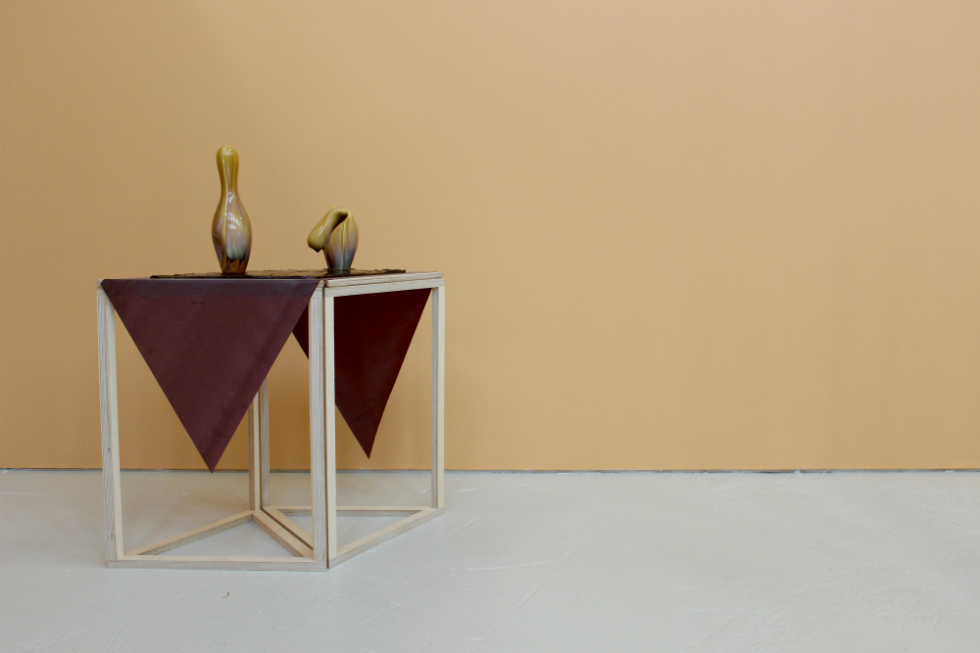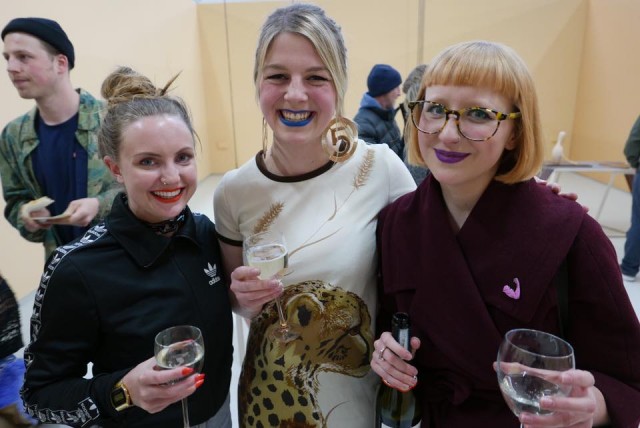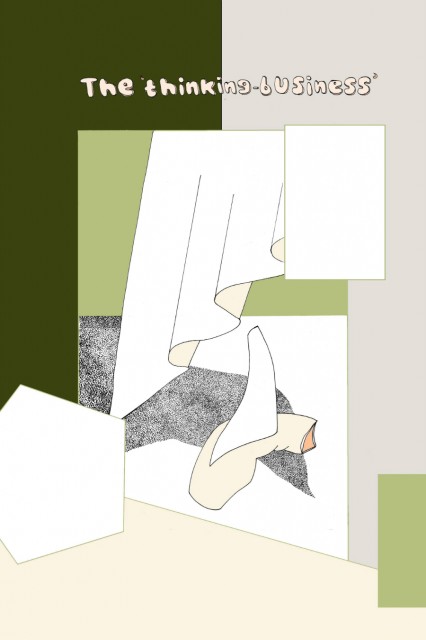Charting The Development Of Friendship: Thinking About The ‘thinking-business’

For and with each other: Caitlin Merrett King’s essay on The Royal Standard’s new exhibition, The ‘thinking-business’, explores how artists Rebecca Ounstead and Paloma Proudfoot are changing our interpretation of friendship as a tool for production…
The political theorist Hannah Arendt and writer Mary McCarthy sustained a remarkable 25 year correspondence which has been documented in Between Friends: The Correspondence of Hannah Arendt and Mary McCarthy 1949-1975, edited by Carol Brightman. Within the letters the women discuss their political views, their work and relationships, offering an intense mutual intellectual and emotional support.
Their friendship, often described by their friends as a “love affair”, has been heralded as a feminist triumph, an important contemporary presentation and philosophy of female partnership and loyal sorority, and as antidote to the ostensibly male-centric philosophical discourse on friendship. See Jacques Derrida’s The Politics of Friendship, for example, where he notes this discord as a development from ancient Greek thought that as friendship is ultimately a relationship of equal standing based on a mutual freedom, slaves and women are exempt from such partnerships.
In an attempt towards a new philosophy of female-centric friendship, Céline Condorelli discusses Arendt and McCarthy’s letters in Friendship [1]. Condorelli is an artist, architect and writer who, like Arendt, believes in the power of friendship as a means for political change based on its establishing of a mutual support and responsibility. She has written extensively on the subject of friendship and collaboration with a focus on institutional critique and making art public, research which manifests itself within her position as architect-curator at Eastside Projects, Birmingham.
Friendship is defined by Condorelli as support in practice. In The company we keep: a conversation with Avery F. Gordon, a discussion in three parts with Gordon, a sociologist and friend of Condorelli, they discuss how friendship can exist as both an association with people and an association with ideas [2]. When we befriend a person, we also befriend their issues and interests or we attempt to, having more of desire to understand a person’s ideas because we are friends with them.
Through operating within these traditional structures of friendship and befriending, what Arendt has coined as “the thinking-business” [3] happens, i.e. “work in friendship and friendship in work” [4]. By “work” I am referring to an intellectual labour as well as a physical one, a working through of ideas together within an environment of emotional labour exchange, talking through our problems with friends towards social and personal change.

“It’s not so much that we think alike but that we do this thinking-business for and with each other.” [5]
The exhibition which takes its title from the above brings together new works by Paloma Proudfoot and Rebecca Ounstead. The artists, who had never worked together previously, were introduced by Emma Curd, a current Director at The Royal Standard, in an attempt to establish a new collaboration to the end of exploring friendship as a means of art production and exhibition-making.
Initially drawn to both artists’ use of materials and objects to explore gender and elements of the social, as well as their use of performers to activate works within an installation, Curd was interested in allowing the artists to further explore the collaborative nature of their practices, inviting them into a long-distance art relationship – blind date style. Curd presented Ounstead and Proudfoot with the letters between Arendt and McCarthy, and Condorelli’s writings on friendship as a theoretical basis for the exhibition and the artists’ own correspondence and working partnership.
Here, Curd’s relationship could be analysed as one of a third participant, a facilitator and match- maker, pairing the two artists based on mutual interests and the aesthetic of their practices. In To All Those Who Set the Stage, Jan Verwoert comments on how when a host invites others to partake in an event they must eventually relinquish their power to those they have invited [6]. Within this lies the anxiety of establishing a friendship, and curating an exhibition, for which the outcome is out of your immediate control; the friendship that develops, based on the artists’ thinking-alike, becomes their own “thinking business” outside of an initial curatorial strategy.
Within the context of the contemporary art world, group exhibitions rarely demand the development of friendships between exhibiting artists. Artists’ work is often chosen by a curator to serve a certain purpose or to answer a particular curatorial question. The exhibition text openly questions the curatorial intentions of attempting to establish a friendship between Ounstead and Proudfoot within the institution; questioning whether friendship must be a naturally occurring bond, or, “whether productive friendship can be manufactured.”
The ‘thinking-business’, however, has a meta-intention; the work involved and the exhibition itself being about and with the desire to form new relationships of support outside of the curator’s aims. Curd is explicit about her position being that of a facilitator rather than curator, in that she wants to allow Ounstead and Proudfoot to have this freedom and not be tethered to producing work that might directly respond to their newly commissioned friendship. Herein lies the generosity of support that Condorelli discusses as integral to friendship [7].
But what does it mean to label this new collaboration as a friendship? The pair discuss the text by Condorelli and her bringing of friendship into work on which Ounstead comments that “traditionally we see physical and intellectual labour as separate, or that friendship is something we do in our free time.” What then happens, for example, when we decide to do our intellectual work in the pub? We have our exhibition meetings with other artists over dinner, or we socialise in the studio, and therefore the divisions between work and leisure become blurred.
Something about the work ethic of millennials can be considered here, and the breakdown of the nine-to-five working schedule for young people with multiple occupations. When your “other” work, i.e. your artwork, is something that you enjoy and not necessarily something you do for money, it must be done in and around your paid work. For example, I am writing this on the train from Liverpool to Glasgow on my way to work, after which I will go home and carry on writing.
The artist, more often than not, is doing something else. Ounstead and Proudfoot embrace this work-life crossover through employing the social in their practices often through the use of performers. Proudfoot regularly makes work with Aniela Piasecka, a dancer who performs alongside Proudfoot, activating artworks made by Proudfoot as props within an installation. Their performances involve simulations of intimate and sensual activities. Their relationship and their intimacy is enticing and flaunted in a way which challenges our intrigued gaze. Proudfoot and Piasecka are also the artistic directors of Stasis, an all female performance and live art company. (See their recent collaboration with Nautilus Rising and Daniel Cook, V: Faux Pas)

As a personal trainer and bodybuilder, Ounstead sees the body as art form, her personal trainer business is called Sculpt. In the exhibition text she comments: “Someone came up to me in a show recently and asked what my references were, and I was just like, ‘to be honest, I’ve just been being a personal trainer for a year and so now I’m making work about living in that culture’.” Her clients regularly feature in her work, and within this exhibition one male body is reduced to a shiny and taut surface printed onto lycra and draped over hanging bars.
Collaboration, and a holistic approach to art-making, is natural within both artists’ practices. Their friends, who are also their colleagues, become materials within their work. Their various strands of work and life combine to become their artwork. But what of their collaboration with each other for this exhibition? How can we determine the success of the friendship that has been created?
The transcript of the conversation between Ounstead and Proudfoot, that is featured in the exhibition text, makes public the correspondence between the artists that otherwise wouldn’t be documented. Presented as a behind the scenes feature, perhaps this is actually the main work of the whole project. It is a nod to Arendt and McCarthy and their befriending and collaboration of ideas; a documentation of the growth of a new collaboration which Curd hopes will develop long beyond the exhibition period. The conversation between Ounstead and Proudfoot is evidence of the real thinking-business, as it charts the development of friendship, the working through of information, issues and thoughts together, for and with each other.
Caitlin Merrett King
[1] Condorelli, C. (2012) Friendship, Reprint, Mousse, Issue 32
[2] Condorelli, C. (2014) The Company She Keeps. (London: Book Works)
[3] Brightman, C. (ed.), (1995) Between Friends: The Correspondence of Hannah Arendt and Mary McCarthy 1949-1975 (USA: Harcourt Brace)
[4] Condorelli, C. (2012) Friendship, Reprint, Mousse, Issue 32
[5] Brightman, C. (ed.), (1995) Between Friends: The Correspondence of Hannah Arendt and Mary McCarthy 1949-1975 (USA: Harcourt Brace)
[6] Verwoert, J. (2012) To All Those Who Set the Stage, ‘Of Hospitality’ symposium at Smart Museum of Art, May 5, 2012 URL: https://vimeo.com/41999945
[7] Condorelli, C. (2007) Support, participation, and relationships to equity: Conversation between Celine Condorelli and Eyal Weizman
See The ‘thinking-business’ at The Royal Standard, Northern Lights, Liverpool, until Sunday 28 May 2017; open Fridays, Saturdays and Sundays, 12-5pm
Images, from top: The ‘thinking-business’ installation shot, at The Royal Standard, courtesy Becky Peach; artists Rebecca Ounstead and Paloma Proudfoot with curator Emma Curd, courtesy Emma Curd; exhibition illustration and publication by Sumuyya Khadar





